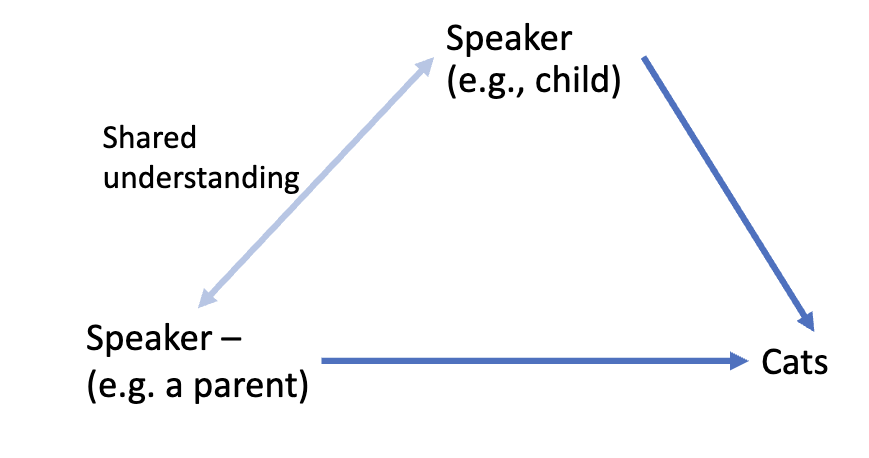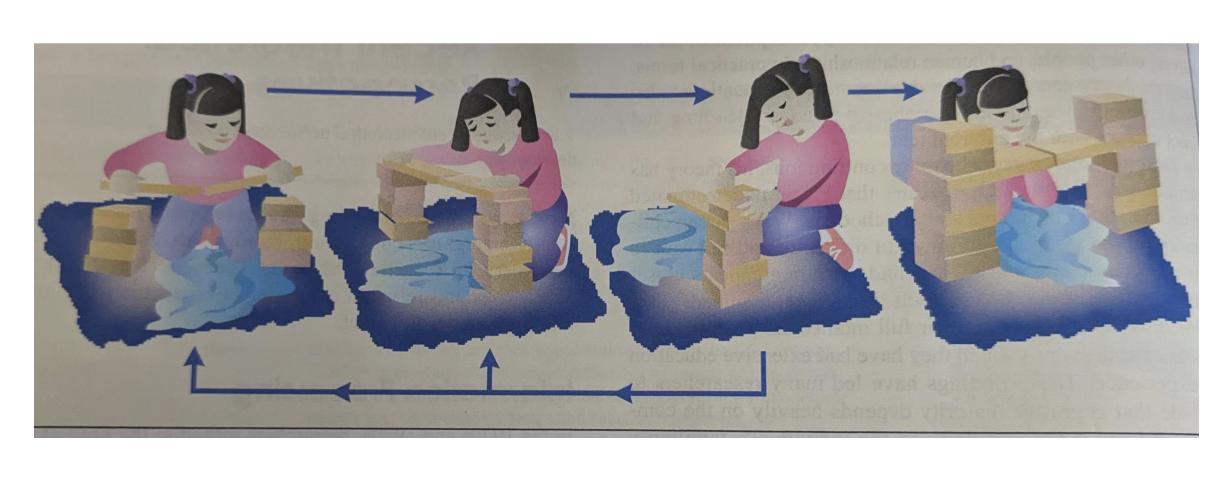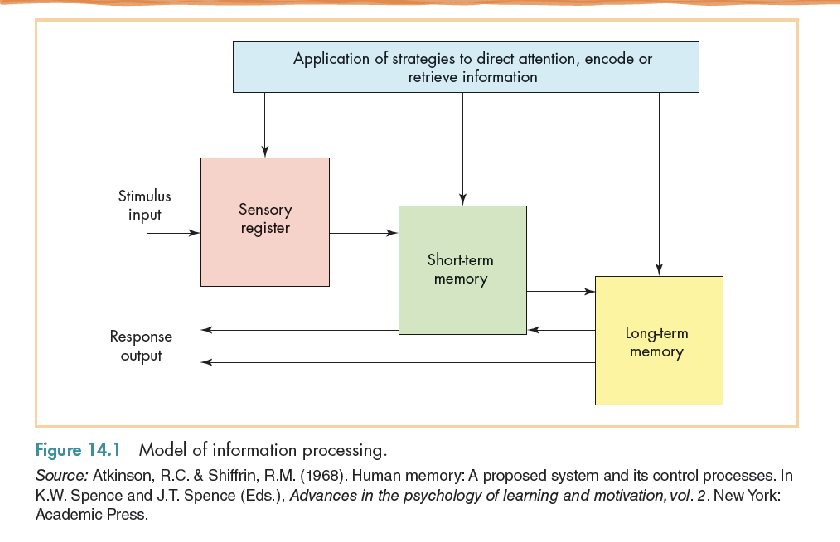Developmental psychology - Week 5
1/38
Earn XP
Description and Tags
Cognitive development theorists
Name | Mastery | Learn | Test | Matching | Spaced |
|---|
No study sessions yet.
39 Terms
Cognitive development
Includes changes in attention, academic achievement, memory, problem-solving, imagination, language, creativity, and everyday knowledge. Children are not passive perceivers of the world; they make meaningful interpretations.
Theoretical perspectives
Cognitive-Developmental Theory - Piaget: Children actively want to achieve equilibrium (balance)
Sociocultural Theory - Vygotsky: Children acquire new ways of thinking and behaving through social interaction.
Information processing: Information is actively coded, transformed, and organised.
Piaget: Cognitive - Developmental Theory
Piaget proposed that we are born with a cognitive structure (‘architecture’) that determines how interactions are experienced and what knowledge is acquired through them. The mind is organized into schemas, which are mental representations that guide your behavior. By interacting with the world, schemas become differentiated as a product of experience, this is done by assimilation and accommodation.
Two Core Processes
Adaptation - we adapt to the world, through either assimilation or accomodation. THis is a Two core process that modify schema
Assimilation
Occurs when new information is incorporated into the existing schema.
Accomodation
Occurs when new information does not fit into the existing schema, so a different schema is created to create a state of equilibrium
Achieving equilibration
If reality appears to fit with what is known, the cognitive system is in equilibrium. Development is triggered by disequilibrium, and the human infant is a self-correcting organism as disequilibrium is not the preferred state. Thus, adjustment needs to be made, either accommodating or assimilating.
Example: Baby in equilibrium if everything can be grasped in the same way (every grasping action and result fits with the schema for grasping). Baby would be thrown into disequilibrium if grasping action doesn’t produce the desired result. Adjustments would be made as a result via accommodation into a state of cognitive equilibrium.
How do they learn?
Through the resolution of disequilibrium - Via self-discovery, ‘active’ participation, peer interaction - ‘Socio-cognitive conflict’.
Explicit adult instruction is not effective because ‘negotiation’ is less likely to take place.
Piaget’s stages of development
Sensorimotor (Birth-2 years) Infants “think” by acting on the world with their eyes, ears, hands, and mouth. As a result, they invent ways of solving sensorimotor problems, such as pulling a lever to hear the sound of a music box, finding hidden toys, and putting objects into and taking them out of containers.
Preoperational (2-7 years) Preschool children use symbols to represent their earlier sensorimotor discoveries. Development of language and make-believe play takes place. However, thinking lacks the logic of the two remaining stages.
Concrete operational (7-11 years) Children’s reasoning becomes logical and better organized. School-age children understand that a certain amount of lemonade or play dough remains the same even after its appearance changes. They also organize objects into hierarchies of classes and subclasses. However, children think in a logical, organized fashion only when dealing with concrete information they can perceive.
Formal operational (11 years and onwards) The capacity for abstract, systematic thinking enables adolescents, when faced with a problem, to start with a hypothesis, deduce testable inferences, and isolate and combine variables to see which inferences are confirmed. Adolescents can also evaluate the logic of verbal statements without referring to real-world circumstances.
Measuring Egocentrism: Three Mountains Task
The Three Mountains Task, developed by Piaget, is a test used to study children's ability to take another person's perspective, egocentrism. In the task, children are shown a 3D model with three mountains and objects placed on them. The child is asked to describe the scene from their viewpoint and then choose which picture shows how the scene looks from a doll's perspective. Young children (around 4-6 years) typically struggle to select the correct picture, showing egocentrism (believing others see things as they do). Older children (around 7-8 years) can correctly identify the doll’s perspective, indicating they have developed the ability to understand that others can have different viewpoints. The task highlights the development of cognitive abilities and theory of mind, illustrating how children move from self-centered thinking to understanding others' perspectives as they grow.
Measuring egocentrism: Hide & Seek
Everyday example of egocentrism - child hides their own eyes, or turns away in the apparent belief that others cannot see them
Measuring Conservation
The same amount of water from two identical beakers was then poured into a different beaker size; children were asked if the amount of water was the same or different compared to each beaker. Children under the age of 7 said no, failing to realize that specific properties remain constant despite perceptual change.
Critically evaluate Piaget’s approach defining context
Responding to a question depends on the interpretation; children might not be failing the tests - rather there is a problem with how the questions are asked and therefore interpreted by children.
Context is a matrix of physical, social, mental, & historical conditions. Every time a question is asked, there is a context: Who is asking the question? What is the relationship between? What to the child before the question was asked?
Alternative approach: Q. Is cognitive ability situation-specific?
manipulate context > reveal/hide cognition?
emphasis on context-specificity of thought (Cole, 1992)
Contextualizing conservation
Tradtional view by Piaget (1952): Child has not “conserved” the numerical properties of the array.
McGarrigle & Donaldson 1974 Naught Teddy: Some children can conserve -
‘Naughty Teddy’ expt. with 6-year-olds
(McGarrigle & Donaldson 1974)
• Teddy appears and ‘messes up’ (i.e.,
spatially transforms) the two sets >
accidentally
• Ask: “I know he has messed the blocks
around, but do we still have the same now?‟
• Piagetian task = 40% children conserving
• Naughty Teddy = 70% children
Children can give the correct answer when the question was contextualised.
Criically evaluate Piaget’s approach: Asking the same question twice
Could asking the same question twice be misleading? (Rose & Blank, 1974)
Standard version
• Experimenter asks: “Are they the same (do they have the same amount?)”
• watch as the Experimenter transforms row
• Experimenter asks again: “Are they still the same?”
The child would think: “What does the Experimenter want me to figure out?
One-judgment version
• If you only ask the question once
e.g., child questioned only after transformation - number of conservation
errors is halved!
Key message: asking the same question twice that leads children to changing
their answer
Critically evaluate Piaget’s approach:
Asking the same question twice
Piaget summary
Children are not passive perceivers, they adapt to the world through assimilation and accommodation to their schemas.
Classic Piaget’s tasks:
• Perspective taking (3 mountain tasks)
• Conservation tasks (volume, number, & weight).
• Context and phrasing the question plays a key role in these tasks.
Vygotsky: Socio-Cultural theory
Emphasized the social nature of development, believing human development and culture were interwoven. He proposed the crucial role of language (social dialogue) and social interaction.
Adults (and more experienced peers) act as experts to help children through scaffolding, help children to master culturally meaningful activities and skills.
For Vygotsky: cognitive development is a socially mediated process.
Comparing Piaget & Vygotsky
Both agree that cognitive development results from the internalization of experience. However, Piaget emphasized the physical environment and supported the idea of children as little scientists. Whereas Vygotsky placed emphasis on the social environment, such as social interactions with parents, siblings, teachers, etc.
The importance of a rich environment
Vygotsky had a cultural focus, social interaction, and the role of adults (providing support).
Socio-cultural approach to cognitive development see these routines, everyday interactions as being crucial to pushing development forward.
Three levels of human development
Cultural aspects - intellectual, material, scientific, and artistic language, have been received from past generations
Interpersonal aspects - the role of others, the ZPD, cognition is a result of the interaction.
Individual aspects - constructive nature, children construct their own knowledge, contributing to their own development (similar to Piaget).
Vygotsky’s main ideas
Knowledge originated in socially meaningful activity
The ability to think and reason by and for ourselves (language) is the result of a fundamentally social process.
At birth, we are social beings, capable of interacting with others- social and cultural factors make an important contribution to human intelligence.
The role of the ZPD and intersubjectivity.
Intersubjectivity
It is the shared understanding or perception between two people.

The Zone of Proximal Development
Vygotsky claimed that all developing individuals have both an actual developmental level and a ZPD.
Key messages:
Children learn through the ZPD
There is an emphasis on social (teachers, parents), culture (art, language, songs), and learning from others (peers) in development.
Rejected Piaget’s idea that development unfolds according to own timetable without influence from school learning.
The ZPD is where children could be with the help of an adult through scaffolding, not where they are in actuality.
Scaffolding
It is a temporary structure—the role played by parents, teachers, and others through which children acquire their knowledge and skills (Wood et al., 1976). As a task becomes more familiar to the child and more within its competence, those who provide the scaffold leave more and more for the child to do until the child can perform the task successfully. The developing thinker does not have to create cognition ‘from scratch’: there are others available who have already ‘served’ their apprenticeship (providing a temporary framework to support the less experienced individual)
Scaffolding example: Freund (1990)
3 and 5 year olds had a furniture sorting task; one group completed a task on their own, one group completed the task with their mother, then both groups completed the post-test (did another puzzle on their own).
Results: The mother group was more advanced on the post-test. Both the 3 and 5-year-old children who had the benefit of interacting with their mother performed much better than children who had no scaffolding—showing that it is more beneficial to complete a task with a parent for a child than individually.
Scaffolding example: Conner, Knight & Cross (1997)
The effect of scaffolding on 2-year-olds for problem-solving tasks (complete puzzle (nest of cups), read ‘Hungry Bear’ story); quality of scaffolding behavior were coded (specific comment or general verbal one).
The quality of scaffolding predicted a child’s performance on various tasks - a follow-up study showed effects continued well into the future.
Mothers and fathers were equally effective at scaffolding; quality matters.
The importance of language for Vygotsky
Language is a key part of Vygotsky’s ideas because:
Language makes thinking possible (Piaget didn’t consider this)
Language regulates behavior (self-regulation)
Language is the basis of culture
Vygotsky said that language goes through stages and has different functions within each stage.
Three stages in the development of function of speech (Vygotsky, 1962)
Social speech - from parents and caregivers to the child- is also used to regulate behavior.
Private speech - private speech is defined as overt, audible speech that is not addressed to another person, mainly occurring between the ages of 3-7. Children talk to themselves to guide their behavior.
Inner speech - internal silent verbal thought (language is first used socially then turned inwardly).
The role of private speech
Language, as a tool of thought, enables the development of executive functions (exert more self-control over their thoughts). Speech enables task completion - but up to a certain point (ZPD) - the harder the task, the more use of private speech.
Private speech example
Berk (1994), found that 6-year-olds spend on average 60% of the time talking to themselves whilst solving problems in maths. Quality of speech was important - those asking questions about what needed to be done did better at maths over the following year, self-guiding speech seems to make it better to focus attention on the task at hand.
Egocentric speech vs private speech
Piaget and Vygotsky differed on why they thought children did this early type of speech
Piaget argued that speech was initially ‘egocentric’ children talked for their selves, and children express thoughts in whatever form they happen to occur. As egocenticism declines, so does egocentric speech.
Vygotsky suggested that speech was traveling in the other direction - languages helps children think about their mental activities and behavior and gives a foundation for higher cognitive processes (planning, problem-solving, etc.) Find tasks easier by internalized speech.
Vygotsky evaluated - strengths
The importance of social context was underestimated by Piaget, and Vygotsky acknowledges it. There are cultural differences in development.
In relation to education, the major significance of ZPD is that it suggests the upper and lower limits, or the ‘zone,’ within which new learning will occur. If the instructions are too difficult or pitched too high, the learner is likely to become frustrated or tuned out. If it is too low, the learner is presented with no challenge and simply does not learn anything.
Vygotsky evaluated - weaknesses
There may be other reasons why people learn better in the presence of others such as age, the comparative ability level of partners, motivation, confidence, and the task.
There is also no systematic analysis of the child’s internal developmental processes - no real account of the type of social interaction that promoted cognitive development (little empirical evidence of his theories).
Summary of Vygotsky
Focuses on the importance of a rich environment in development and parents in guiding children.
Zone of Proximal Development - evidence of scaffolding and its implication (advantage) on children’s learning.
Language (private speech) plays an important role in guiding children’s behaviour.
Information processing
Used to describe the development of cognitive abilities. It breaks down thinking into the sub-components.
Information processing emphasizes the flow of information through different components (coded, transformed, & organized). Looks at the precise steps individuals take to problem-solve and complete tasks. The role of available knowledge and memory capacity is important in influencing performance.

Model of information processing (Atkinson & Shriffin, 1968)
Describes cognitive processing in terms of 3 memory stores and the control processes that operate on them:
Sensory register - sights and sounds represented and stored briefly. Attending to that information increases the chances that it will transfer to the next stage in the model.
Short-term memory - limited capacity compared to sensory register, working space to hold and manipulate information
Long-term memory - permanent knowledge base
The model emphasizes the flow of information through or between different components.
Model of information processing
Information flows through each stage; we use different mental strategies to retain the information.

Information processing: strengths & weaknesses
Strengths: Allows for rigorous research methods - tackles how individuals tackle cognitive tasks across ontogeny, breaks down thinking into smaller components.
Weaknesses: Difficult to combine smaller components into a comprehensive theory, and it is hard to apply to non-logical thinking like creativity & imagination.
Summary of information processing
The human mind acts as a system in which information flows from a stimulus to a behavioral reponse. Information is coded, transformed, and organized.
Can be a whole cognitive system approach or for mastering one or more tasks.
Individuals actively make sense of their own thinking through continuous change as they age.